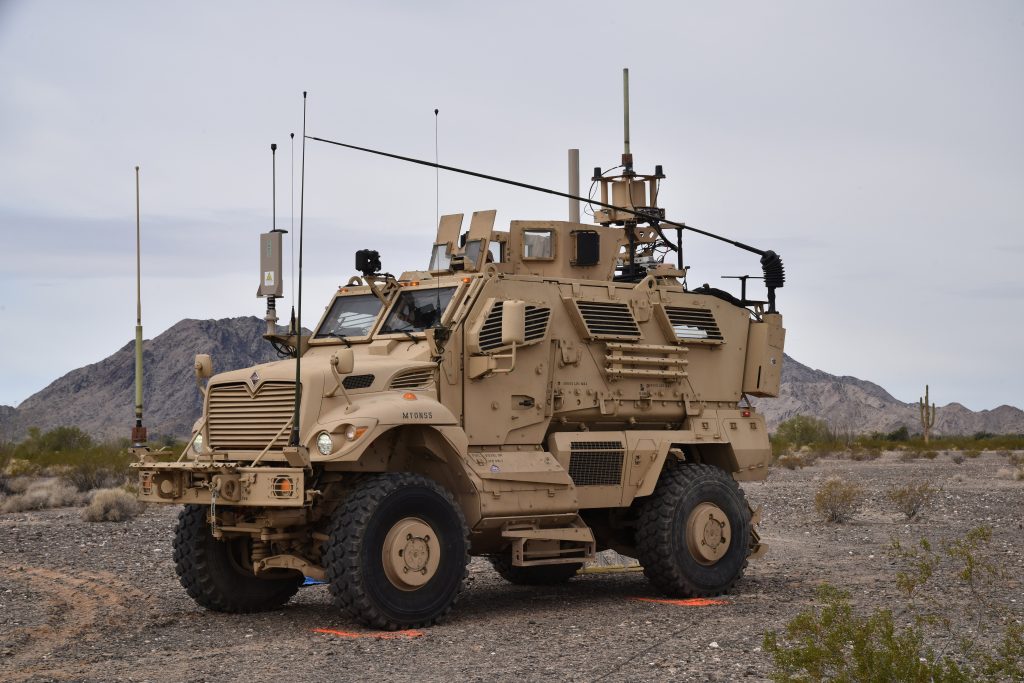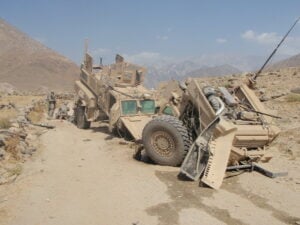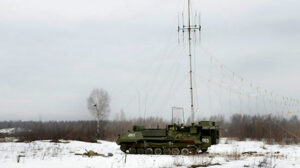By SYDNEY J. FREEDBERG JR
 While the Army put out a press release Aug. 2, and officials answered some of my follow-up questions, they were understandably unwilling to detail the capabilities or even the exact number of the Electronic Warfare Tactical Vehicles (EWTVs). What is clear, though, is that the EWTVs are a small but significant step towards rebuilding the Army’s disbanded capability to attack enemy communications, the electronic linchpin of modern warfare.
While the Army put out a press release Aug. 2, and officials answered some of my follow-up questions, they were understandably unwilling to detail the capabilities or even the exact number of the Electronic Warfare Tactical Vehicles (EWTVs). What is clear, though, is that the EWTVs are a small but significant step towards rebuilding the Army’s disbanded capability to attack enemy communications, the electronic linchpin of modern warfare.
The Army’s high-priority Rapid Equipping Force (REF) coordinates the effort with Army Cyber Command (ARCYBER), Army Test & Evaluation Command (ATEC), Training & Doctrine Command (TRADOC) capability managers (who write official requirements), and multiple program offices. (The EWTV effort precedes the Army’s creation of Cross-Functional Teams to streamline acquisition, but the coordinated approach is similar). REF officials told me the lead contractor for the EW gear is SRC Inc. and the “base system” installed on the vehicle is SRC Inc.’s CREW Duke, with unspecified modifications.
An MRAP (Mine-Resistant Ambush-Protected) truck torn apart by an IED (Improvised Explosive Device)
 What can Duke do? Widely deployed in the Army and Marine Corps, Duke began life as a low-power, short-range jammerto keep radio-controlled roadside bombs from going off. (CREW is a nested acronym for Counter-RCIED (Radio-Controlled Improvised Explosive Device) Electronic Warfare). But Duke evolved into a much more sophisticated systemcapable of detecting and disrupting a wide range of signals, from cellphones to the control links for enemy drones, as tested in the joint Black Dart experiments.
What can Duke do? Widely deployed in the Army and Marine Corps, Duke began life as a low-power, short-range jammerto keep radio-controlled roadside bombs from going off. (CREW is a nested acronym for Counter-RCIED (Radio-Controlled Improvised Explosive Device) Electronic Warfare). But Duke evolved into a much more sophisticated systemcapable of detecting and disrupting a wide range of signals, from cellphones to the control links for enemy drones, as tested in the joint Black Dart experiments.
The modified Duke installed on the EWTV is specifically built to “sense and jam enemy communications and networks,” not just drones or IEDS, and it can do so “across a broad spectrum of frequencies and with myriad waveforms at significant power.” Specifically, it can detect and analyze radio-frequency signals (a function known as electronic support, ES), then transmit its own RF signal to disrupt and deceive the enemy (electronic attack, EA).
It’s worth noting that when EW systems go from passive listening to active jamming, their signal tends to show up brightly on the enemy‘s EW sensors, which can try to triangulate their location for airstrikes or artillery barrages. That’s a big part of the reason the Army wants “precision” electronic warfare that transmits just enough power at just the right frequency in just the right direction to shut the enemy down, rather than broadcasting a high-power signal that’s easily detectable on multiple frequencies. (The other reason is such brute-force blasting tends to shut down friendly radios and radars too). The ultimate precision technique is to use a low-power EW signal as a carrier for a cyber attack, hacking into the enemy network rather than overpowering its transmissions, and the Army is in fact merging its cyber and EW branches.
But even with precision electronic warfare, jamming from one place for a long time is generally an invitation for enemy fire, so EW systems need to be mobile. (Even then friendly forces generally don’t hang out too close when enemy artillery is in range). That brings us to the TV part of EWTV, the Tactical Vehicle.
Russian Krasukha-2 electronic warfare system with dish deployed. The system was reportedly used in Syria.
Platforms & Tactics
SRC’s electronic warfare kit is installed on a four-wheel drive MaxxPro Dash, one of the multiple types of MRAP (Mine-Resistant Ambush-Protected) armored trucks bought for the war in Iraq. That’s a frontline vehicle for counterinsurgency but more of a supporting player in a great power war, where heavier 8×8 Strykers, tracked Bradley variants, and M1 Abrams tanks would be in the forefront. Since the unspecified “operational requirement” the EWTV was built to meet is almost certainly Russian EW in Europe, the vehicle is probably intended to pull up well short of the firing line and jam enemy systems from a distance of a few miles at the very least. That’s a big departure from most of the EW equipment deployed in Afghanistan and Iraq, which was either mobile but short-ranged — like the original CREW — or higher-powered but static, emplaced on Forward Operating Bases that would be easy targets for Russian or Chinese-style missiles and artillery.
Russian Borisoglebsk-2 long-range EW system with antenna mast deployed.
 The size of the MaxxPro Dash also puts an upper limit on the sheer power of the sensors and jammers aboard. (Although, again, the Army’s more interested in precision than raw power). While MRAPs are generally roomier than tracked troop carriers like the M2 Bradley — the MaxxPro Dash can take a 10,000-pound payload — they’re still significantly smaller than the tractor-trailer-sized systems in use with many Russian EW units, which have ranges in the hundreds of miles. The antennas installed on the EWTV are also a lot smaller than the big dishes and retractable masts on the Russian heavy-duty systems, again suggesting lower power and shorter range. Yes, Moore’s Law and precision jamming techniques let you do more with a smaller piece of kit than in the past, but at some point the laws of physics limit your reach.
The size of the MaxxPro Dash also puts an upper limit on the sheer power of the sensors and jammers aboard. (Although, again, the Army’s more interested in precision than raw power). While MRAPs are generally roomier than tracked troop carriers like the M2 Bradley — the MaxxPro Dash can take a 10,000-pound payload — they’re still significantly smaller than the tractor-trailer-sized systems in use with many Russian EW units, which have ranges in the hundreds of miles. The antennas installed on the EWTV are also a lot smaller than the big dishes and retractable masts on the Russian heavy-duty systems, again suggesting lower power and shorter range. Yes, Moore’s Law and precision jamming techniques let you do more with a smaller piece of kit than in the past, but at some point the laws of physics limit your reach.
UPDATED I asked CNA’s Sam Bendett, one of my favorite experts in Russian high-tech systems, how the Electronic Warfare Tactical Vehicle stacked up against the Russian EW arsenal. “Mobility is key in EW, (and) Russian forces have a wide variety of wheeled EW systems that could deploy in as little as 15 minutes,” he told me. “Russia has at least five different truck-mounted EW systems already that have been used extensively in Syria, as well as in a variety of domestic and international drills and exercises.”
“The American EWTV is a definitive step in the right direction, though at this point US capability is behind Russia’s,” Bendett said. “This truck needs to ‘bulk up’ to meet the challenges presented by the constantly-evolving Russian EW capabilities and technologies.”
So the EWTV is by no means the solution to the Army’s electronic warfare shortfalls. The “several” EWTVs now in their final testing for FORSCOM are not necessarily even the prototypes for something that will be later mass-produced.
For one thing, the Army ultimately wants to integrate Signals Intelligence (SIGINT) and electronic warfare into a single platform, since both missions involve detecting and analyzing enemy signals. The EWTV, however, “is not capable of SIGINT.”
The mass-produced solution may not even be on an MRAP truck. While the Army told me that “the Army REF is not considering other platforms for the EWTV at this time,” after experimenting with the EWTV, they may well decide they need a larger platform to carry higher-powered equipment, a better armored platform to carry equipment closer to the front line, or both. (The new turretless utility variant of the M2 Bradley, the Armored Multi-Purpose Vehicle, is one possible option).

No comments:
Post a Comment